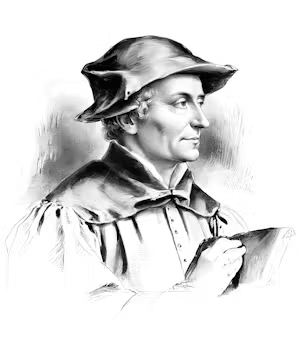Huldrych Zwingli
1484–1531
The Reformation’s Third Man
To cite the subtitle of a 1959 biography of the great Swiss Reformer, Huldrych Zwingli has been very much “the third man of the Reformation.” As such, he has been overlooked to a significant degree by Reformation scholarship. That scholarship has found it easier to focus on Luther and Calvin, both of whom left a clear tradition.
Moreover, Zwingli’s martial approach to the reforming of the late medieval church — which culminated in his death on the battlefield at Kappel in October of 1531 — is hardly a model for imitation. While Zwingli’s fellow Swiss Reformers sought to put Zwingli’s violent death in the best possible light, other Reformers, such as Martin Luther, were not so sanguine about what took place at Kappel. In Luther’s words, Zwingli had died “in great sin and blasphemy.” The challenge of making sense of Zwingli’s end reveals the Swiss Reformer to be a complex figure whose story defies both hagiography and demonization.
To Scripture and Zurich
Zwingli’s birthplace was some forty miles from Zurich in a typical Swiss chalet well over three thousand feet above sea level. After high school in Basel, he attended the University of Vienna for four years and then returned to Basel to study at the university there, a center of Renaissance scholarship. Under the influence of the scholar Thomas Wyttenbach (1472‒1526), Zwingli became committed to the Renaissance ideal of studying the sources of Western culture on antiquity, which led him to embrace the necessity of affirming sola Scriptura for the Reformation of the church (though his own spiritual awakening was still to come).
After the close of his formal academic studies in 1506, he received a call to be the priest in the rural parish of Glarus, where he was to remain till 1516. During this time, he began to seriously question the nature of late medieval Swiss society and its failure to reflect the Christianity of the Scriptures. The Swiss supplied much of southern Europe with mercenaries — indeed, the Vatican still has a Swiss Guard — but with the young men away fighting for money and glory, their communities were being reduced to poverty. Such issues of societal and political declension and the need for community renewal set Zwingli on the road to the Reformation.
A short spell at nearby Einsiedeln, the site of a popular shrine to the Virgin Mary, followed from 1516 to 1518. Sadly, this period ended amid well-founded accusations of sexual impropriety with the daughter of an influential figure in the community. A gift for preaching, though, led to Zwingli’s appointment in late 1518 to the Grossmünster, the main church in the heart of Zurich, a city home to some seven thousand people.
Reformed Turning Points
From almost the very outset of his ministry in Zurich, Zwingli made expositional preaching the heart of his pastorate. In 1519, he also came across some treatises by Martin Luther that convinced him of justification by faith alone. To Zwingli at this time, Luther was nothing less than a new Elijah. But the Zwinglian Reformation was not ultimately dependent on Luther. In Zwingli’s words, “If Luther has drunk where we have drunk, then he has in common with us the evangelical doctrine” (Ulrich Zwingli: Early Writings, 176).
In August of 1519, the Black Death (the bubonic plague) also struck Zurich, killing some 1,500 people. Zwingli himself was stricken and came near to death — indeed, rumors outside Zurich placed him among the dead. But he recovered. It was a key turning point in his life, for he committed himself unreservedly to God and the implementation of his will in the Swiss town. As he wrote of God in November 1520, “I have learnt to submit myself utterly to His divine will.”
A second turning point came on the evening of March 9, 1522, during Lent, the traditional medieval time of preparation for Easter. That evening, one of Zwingli’s friends had a simple meal of sausages with some other friends. But this was in defiance of church law, which forbade the eating of meat during Lent. Zwingli, who was present, did not partake, but neither did he object. In fact, the following month, Zwingli issued a short pamphlet defending the sausage-eating that evening and more generally affirming the freedom that God’s people have in Christ.
No More Mass
The key turning point came, however, in 1525, when the mass was abandoned in Zurich. By this point, Zwingli, like Luther, had come to reject the medieval doctrine of transubstantiation in which the Church of Rome argued that the bread and wine ceased to be bread and wine as they became the very body and blood of Christ. But whereas Luther was convinced that the Lord’s Supper still conveyed the very body and blood of Christ along with real bread and wine, Zwingli believed that Christ’s presence was spiritual and not corporeal. When the two German Reformers met at Marburg in 1529, this difference proved to be a major roadblock to a union of these two remarkable men and their Reformations.
Two years after this meeting that spelled the decisive division between the Lutheran and Reformed wings of the German Reformation, Roman Catholic troops marched on Zurich in the confidence that the Lutherans would not come to the aid of the Zurichers. Although Zwingli died in the ensuing conflict, the Zurich Reformation continued under his loyal coworker, Heinrich Bullinger. And thus Zwingli’s passion for the Scriptures and his determination to live solely under their authority became a key component of the Reformed tradition.
For further reading:
Zwingli: God’s Armed Prophet by Bruce Gordon
Zwingli the Pastor: A Life in Conflict by Stephen Brett Eccher
Michael A.G. Haykin is chair and professor of church history at The Southern Baptist Theological Seminary in Louisville, KY, and author of many books, including Amidst Us Our Beloved Stands: Recovering Sacrament in the Baptist Tradition.


